Direct-to-Satellite IoT Slotted Aloha Systems with Multiple Satellites and Unequal Erasure Probabilities
Abstract
:1. Introduction
1.1. State-of-the-Art
1.2. Novelty and Contribution
2. System Model
3. System Throughput and Packet Loss Rate
3.1. Throughput
3.2. Packet Loss Rate
4. Intelligent Traffic Load Distribution
| Algorithm 1: ITLD—intelligent traffic load distribution. |
2: Evaluating (11), compute the uniform traffic load distribution per position ; 3: For , calculate the throughput per position with (6); 4: Determine the overall throughput with uniform load distribution, ; 5: Find the load factor in each position using (12); 6: Following (13), compute the non-uniform traffic load distribution per position ; 7: Repeat step 4 now to find with for the proposed strategy; 8: Determine the overall throughput with non-uniform load distribution ; 9: If , then . Else, . Thus, . |
5. Numerical Results
5.1. Throughput
5.2. Packet Loss Rate
5.3. Traffic Load Distribution
6. Conclusions
Author Contributions
Funding
Conflicts of Interest
Abbreviations
| CDMA | Code Division Multiple Access |
| CRDSA | Contention Resolution Diversity Slotted Aloha |
| DtS-IoT | Direct to Satellite IoT |
| GEO | Geostationary Orbit |
| HSTN | Hybrid Land-Satellite Network |
| IoT | Internet of Things |
| IRSA | Irregular Repetition Slotted Aloha |
| ITLD | Intelligent Traffic Load Distribution |
| LEO | Low Earth Orbit |
| LPWAN | Low Power Wide Area Network |
| MAC | Media Access Control |
| MIMO | Multiple Input Multiple Output |
| RA | Random Access |
| SAT | Satellite |
| SIC | Successive Interference Cancellation |
| TDMA | Time Division Multiple Access |
| 5G | Fifth Generation of Wireless Communication Systems |
| 6G | Sixth Generation of Wireless Communication Systems |
| ∅ | Empty set |
| Erasure probability | |
| Erasure probability at the kth satellite | |
| Angular variation | |
| Set of data packets successfully received by a different satellite | |
| G | Channel load |
| Total traffic load | |
| Uniform traffic load distribution, per position | |
| Non-uniform traffic load distribution, per position | |
| Set with indexes of the subsets whose intersection must be evaluated | |
| K | Number of satellites in the constellation |
| k | k-th Satellite in orbit |
| M | Positions in each lap |
| N | Number of time-slots |
| n | Number of erasure probabilities |
| Position of the kth satellite | |
| Probability that users transmit in the same time-slot | |
| Packet loss rate | |
| Packet loss rate at the kth satellite | |
| Probability of successful reception, of a given packet, by satellites | |
| Load factor | |
| Probability of successful reception of the same packet by by satellites, | |
| given that u packets were transmitted | |
| Probability of successful packet reception at the kth satellite | |
| First LEO satellite | |
| Second LEO satellite | |
| s | Satellite spacing |
| System throughput | |
| Throughput per position | |
| Throughput at the kth satellite | |
| Throughput for Intelligent Traffic Load Distribution | |
| Throughput for non-uniform distribution | |
| Throughput for uniform distribution | |
| U | Poisson random variable |
| u | Number of users transmitting in the same time-slot |
References
- Raza, U.; Kulkarni, P.; Sooriyabandara, M. Low power wide area networks: An overview. IEEE Commun. Surv. Tutorials 2017, 19, 855–873. [Google Scholar] [CrossRef] [Green Version]
- Onumanyi, A.J.; Abu-Mahfouz, A.M.; Hancke, G.P. Low power wide area network, cognitive radio and the Internet of things: Potentials for integration. Sensors 2020, 20, 6837. [Google Scholar] [CrossRef]
- LoRa Alliance. LoRaWAN Specifications. Available online: https://lora-alliance.org/ (accessed on 14 September 2021).
- Sigfox. What is Sigfox. Available online: https://www.sigfox.com/en/what-sigfox/technology (accessed on 14 September 2021).
- Fraire, J.A.; Céspedes, S.; Accettura, N. Direct-to-Satellite IoT—A Survey of the State of the Art and Future Research Perspectives. In International Conference on Ad-Hoc Networks and Wireless; Springer: Berlin/Heidelberg, Germany, 2019; pp. 241–258. [Google Scholar]
- Akyildiz, I.F.; Kak, A. The Internet of space things/cubesats. IEEE Netw. 2019, 33, 212–218. [Google Scholar] [CrossRef]
- You, L.; Li, K.-X.; Wang, J.; Gao, X.; Xia, X.-G.; Ottersten, B. Massive MIMO transmission for LEO satellite communications. IEEE J. Sel. Areas Commun. 2020, 38, 1851–1865. [Google Scholar] [CrossRef]
- Cisco Visual Networking. Global Internet Adoption and Devices and Connection, 2018 to 2023; Cisco: San Jose, CA, USA, 2020. [Google Scholar]
- Cioni, S.; Gaudenzi, R.D.; Herrero, O.D.R. Nicolas Girault On the satellite role in the era of 5G massive machine type communications. IEEE Netw. 2018, 32, 54–61. [Google Scholar] [CrossRef]
- 3GPP. Study on Narrow-Band Internet of Things (NB-IoT)/Enhanced Machine Type Communication (eMTC) Support for Nonterrestrial Networks (NTN). Technical Specification (TS) 36.763, 3rd Generation Partnership Project (3GPP). 2021. Version 8.15. Available online: https://portal.3gpp.org/desktopmodules/Specifications/SpecificationDetails.aspx?specificationId=3747 (accessed on 14 September 2021).
- Chen, S.; Sun, S.; Kang, S. System integration of terrestrial mobile communication and satellite communication the trends, challenges and key technologies in B5G and 6G. China Commun. 2020, 17, 156–171. [Google Scholar] [CrossRef]
- SpaceX. Starlink Mission. Available online: https://www.spacex.com/ (accessed on 14 September 2021).
- OneWeb. Connect with Purpose. Available online: https://oneweb.net/ (accessed on 14 September 2021).
- Marchese, M.; Moheddine, A.; Patrone, F. IoT and UAV integration in 5G hybrid terrestrial-satellite networks. Sensors 2019, 19, 3704. [Google Scholar] [CrossRef] [Green Version]
- Kassab, R.; Simeone, O.; Munari, A.; Clazzer, F. Space diversity-based grant-free random access for critical and non-critical IoT services. In Proceedings of the IEEE International Conference on Communications (ICC), Dublin, Ireland, 7–11 June 2020; pp. 1–6. [Google Scholar]
- Saeed, N.; Elzanaty, A.; Almorad, H.; Dahrouj, H.; Al-Naffouri, T.Y.; Alouini, M.-S. Cubesat communications: Recent advances and future challenges. IEEE Commun. Surv. Tutorials 2020, 22, 1839–1862. [Google Scholar] [CrossRef]
- Fraire, J.; Henn, S.; Dovis, F.; Garello, R.; Taricco, G. Sparse satellite constellation design for LoRa-based direct-to-satellite Internet of things. In Proceedings of the 2020 IEEE Global Communications Conference (IEEE GLOBECOM), Taipei, Taiwan, 7–11 December 2020. [Google Scholar]
- Fang, X.; Feng, W.; Wei, T.; Chen, Y.; Ge, N.; Wang, C.-X. 5G embraces satellites for 6G ubiquitous IoT: Basic models for integrated satellite terrestrial networks. IEEE Internet Things J. 2021, 8, 14399–14417. [Google Scholar] [CrossRef]
- Lysogor, I.; Voskov, L.; Rolich, A.; Efremov, S. Study of data transfer in a heterogeneous LoRa-satellite network for the Internet of remote things. Sensors 2019, 19, 3384. [Google Scholar] [CrossRef] [PubMed] [Green Version]
- Ferrer, T.; Caspedes, S.; Becerra, A. Review and evaluation of MAC protocols for satellite IoT systems using nanosatellites. Sensors 2019, 19, 1947. [Google Scholar] [CrossRef] [PubMed] [Green Version]
- Abramson, N. The Aloha system: Another alternative for computer communications. In Proceedings of the Association for Computing Machinery Fall Joint Computer Conference, AFIPS 70, New York, NY, USA, 17–19 November 1970; pp. 281–285. [Google Scholar]
- Mahmood, N.H. White Paper on Critical and Massive Machine Type Communication towards 6G. 2020. Available online: https://www.oulu.fi/6gflagship/6g-white-paper-critical-massive-type-communication (accessed on 14 September 2021).
- Berioli, M.; Cocco, G.; Liva, G. Modern Random Access Protocols. Found. Trends Netw. 2016, 10, 317–446. [Google Scholar] [CrossRef] [Green Version]
- Clazzer, F.; Munari, A.; Liva, G.; Lazaro, F.; Stefanovic, G.; Popovski, P. From 5G to 6G: Has the time for modern random access come? In Proceedings of the 6GWireless Summit 2020, Levi, Finland, 24–26 March 2019. [Google Scholar]
- Stefanovic, C.; Popovski, P. Aloha random access that operates as a rateless code. IEEE Trans. Commun. 2013, 61, 4653–4662. [Google Scholar] [CrossRef] [Green Version]
- Casini, E.; Gaudenzi, R.D.; Herrero, O.D.R. Contention resolution diversity slotted Aloha (CRDSA): An enhanced random access scheme for satellite access packet networks. IEEE Trans. Wirel. Commun. 2007, 6, 1408–1419. [Google Scholar] [CrossRef]
- Liva, G. Graph-based analysis and optimization of contention resolution diversity slotted Aloha. IEEE Trans. Commun. 2011, 59, 477–487. [Google Scholar] [CrossRef]
- Zhao, B.; Ren, G.; Dong, X.; Zhang, H. Optimal irregular repetition slotted Aloha under total transmit power constraint in IoT-oriented satellite networks. IEEE Internet Things J. 2020, 7, 10465–10474. [Google Scholar] [CrossRef]
- Zorzi, M. Mobile radio slotted Aloha with capture, diversity and retransmission control in the presence of shadowing. Wirel. Netw. 1997, 4, 379–388. [Google Scholar] [CrossRef]
- LaMaire, R.O.; Zorzi, M. Effect of correlation in diversity systems with Rayleigh fading, shadowing, and power capture. IEEE J. Sel. Areas Commun. 1996, 14, 49–460. [Google Scholar] [CrossRef]
- Fengler, A.; Haghighatshoar, S.; Jung, P.; Caire, G. Grant-free massive random access with a massive MIMO receiver. In Proceedings of the 2019 53rd Asilomar Conference on Signals, Systems, and Computers, Pacific Grove, CA, USA, 3–6 November 2019; pp. 23–30. [Google Scholar]
- Li, P.; Jian, X.; Wang, F.; Fu, S.; Zhang, Z. Theoretical throughput analysis for massive random access with spatial successive decoding. IEEE Trans. Veh. Technol. 2020, 69, 7998–8002. [Google Scholar] [CrossRef]
- Munari, A.; Clazzer, F.; Liva, G. Multi-receiver Aloha systems—A survey and new results. In Proceedings of the 2015 IEEE International Conference on Communication Workshop (ICCW), London, UK, 8–12 June 2015; pp. 2108–2114. [Google Scholar]
- Jakovetic, D.; Bajovic, D.; Vukobratovic, D.; Crnojevic, V. Cooperative slotted Aloha for multi-base station systems. IEEE Trans. Commun. 2015, 63, 1443–1456. [Google Scholar] [CrossRef]
- Koziol, M. Satellites Can Be a Surprisingly Great Option for IoT. IEEE Spectrum. 2021. Available online: https://spectrum.ieee.org/satellites-great-option-iot (accessed on 14 September 2021).
- Munari, A.; Clazzer, F.; Liva, G.; Heindlmaier, M. Multiple-relay slotted Aloha: Performance analysis and bounds. IEEE Trans. Commun. 2021, 69, 1578–1594. [Google Scholar] [CrossRef]
- Matricciani, E. Geocentric Spherical Surfaces Emulating the Geostationary Orbit at Any Latitude with Zenith Links. Future Internet 2020, 12, 16. [Google Scholar] [CrossRef] [Green Version]
- Perron, E.; Rezaeian, M.; Grant, A. The on-off fading channel. In Proceedings of the IEEE International Symposium on Information Theory, Yokohama, Japan, 29 June–4 July 2003. [Google Scholar]
- Lopez-Salamanca, J.J.; Seman, L.O.; Berejuck, M.D.; Bezerra, E.A. Finite-state Markov chains channel model for cubesats communication uplink. IEEE Trans. Aerosp. Electron. Syst. 2020, 56, 142–154. [Google Scholar] [CrossRef]
- Corazza, G.E.; Vatalaro, F. A statistical model for land mobile satellite channels and its application to nongeostationary orbit systems. IEEE Trans. Veh. Technol. 1994, 43, 738–742. [Google Scholar] [CrossRef]
- Akturan, R.; Vogel, W.J. Elevation angle dependence of fading for satellite PCS in urban areas. Electron. Lett. 1995, 31, 1125–1127. [Google Scholar] [CrossRef]
- Rosen, K. Discrete Mathematics and Its Applications, 7th ed.; McGraw-Hill Education: New York, NY, USA, 2011. [Google Scholar]
- Fox, J. Principle of inclusion and exclusion. Lecture Notes. MAT 307: Combinatorics. Available online: http://math.mit.edu/~fox/MAT307-lecture04.pdf (accessed on 14 September 2021).
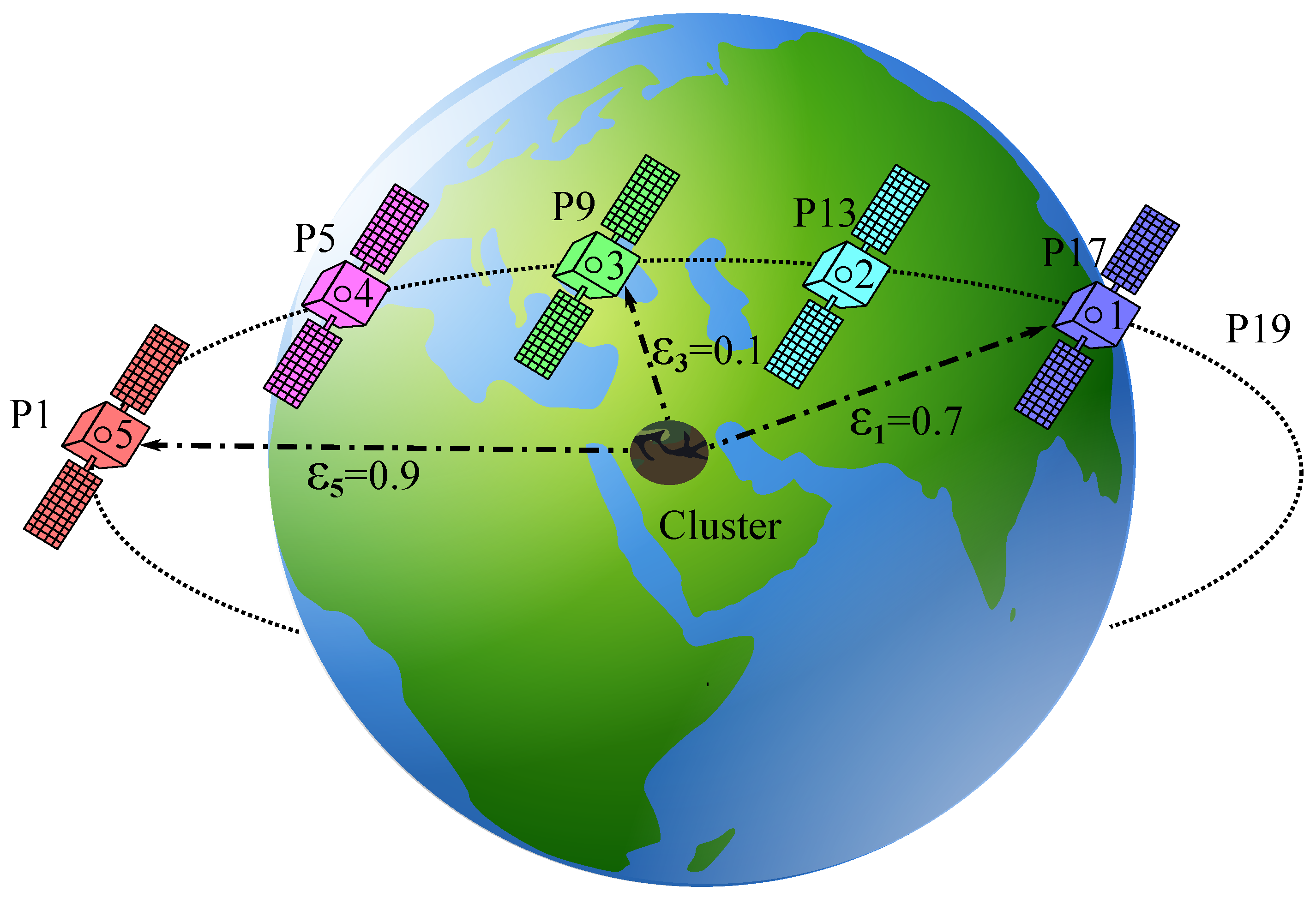
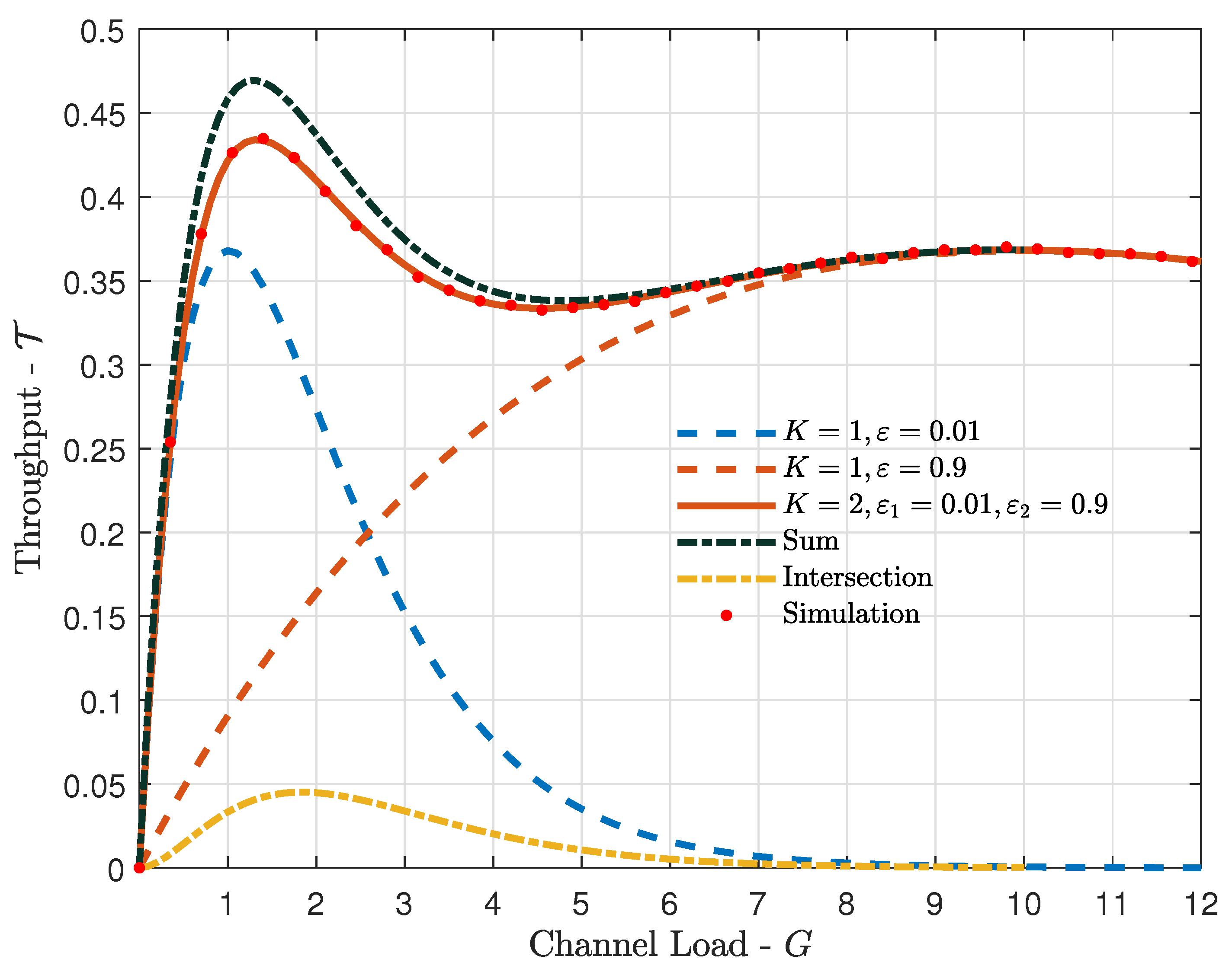
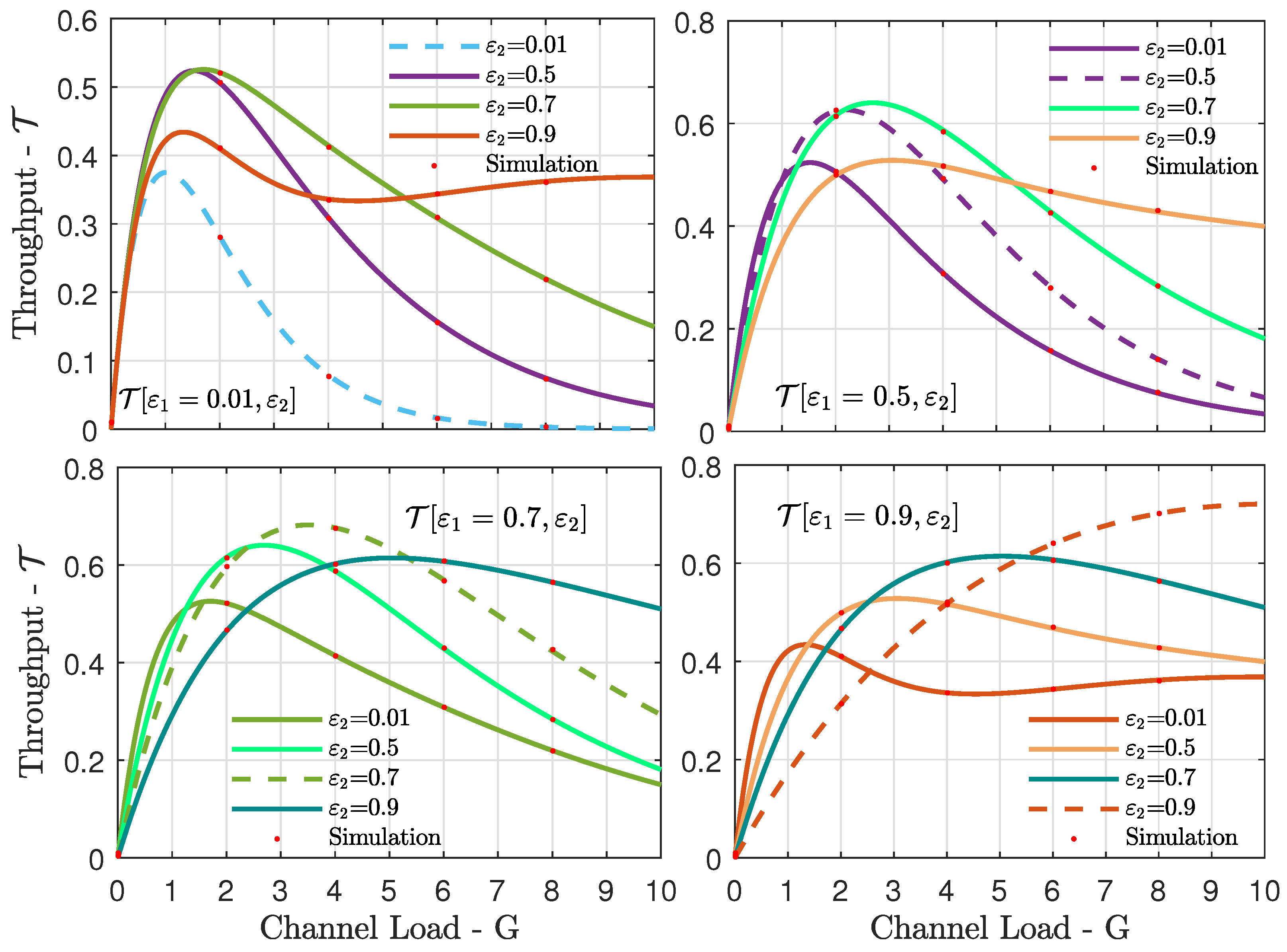
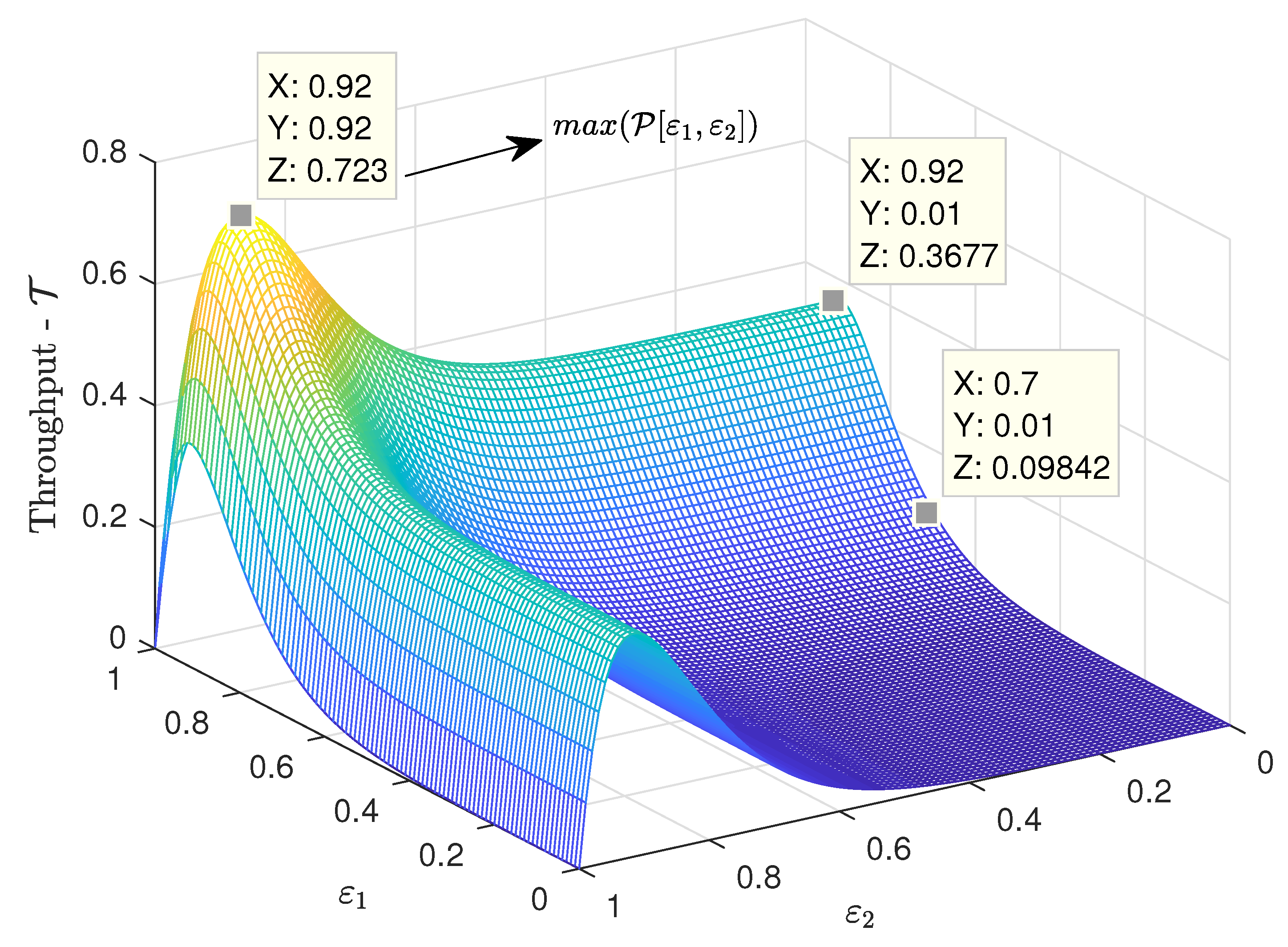
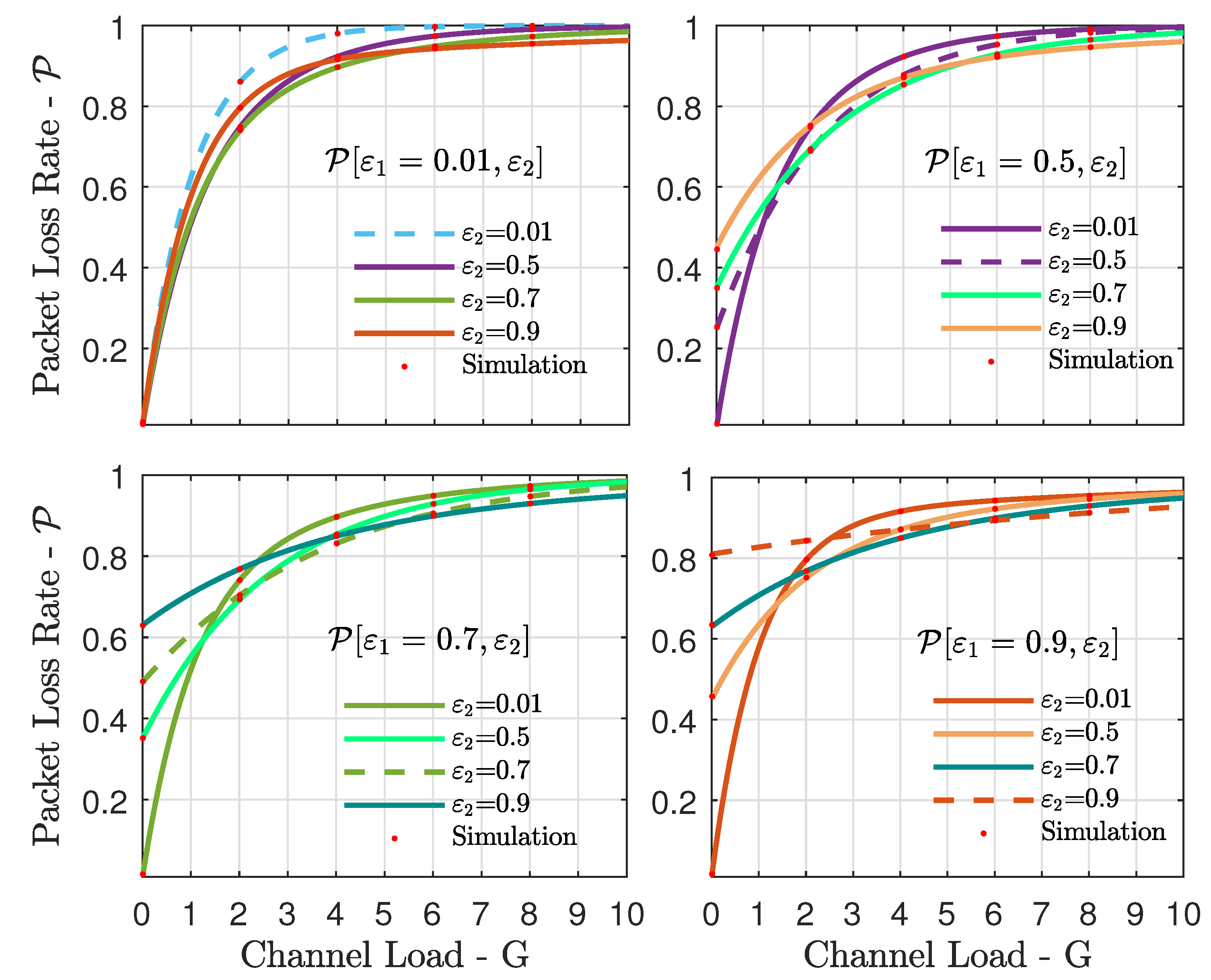
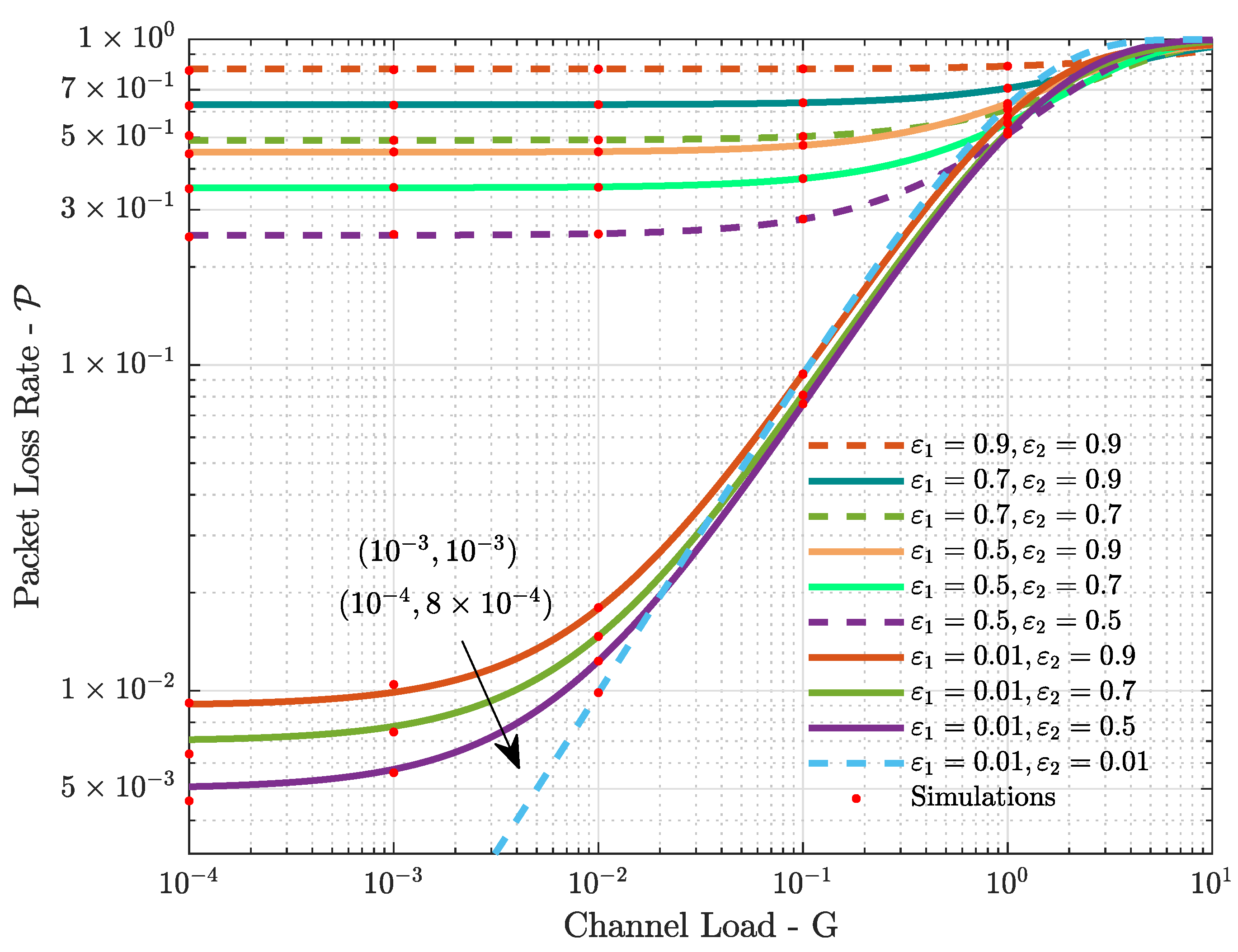
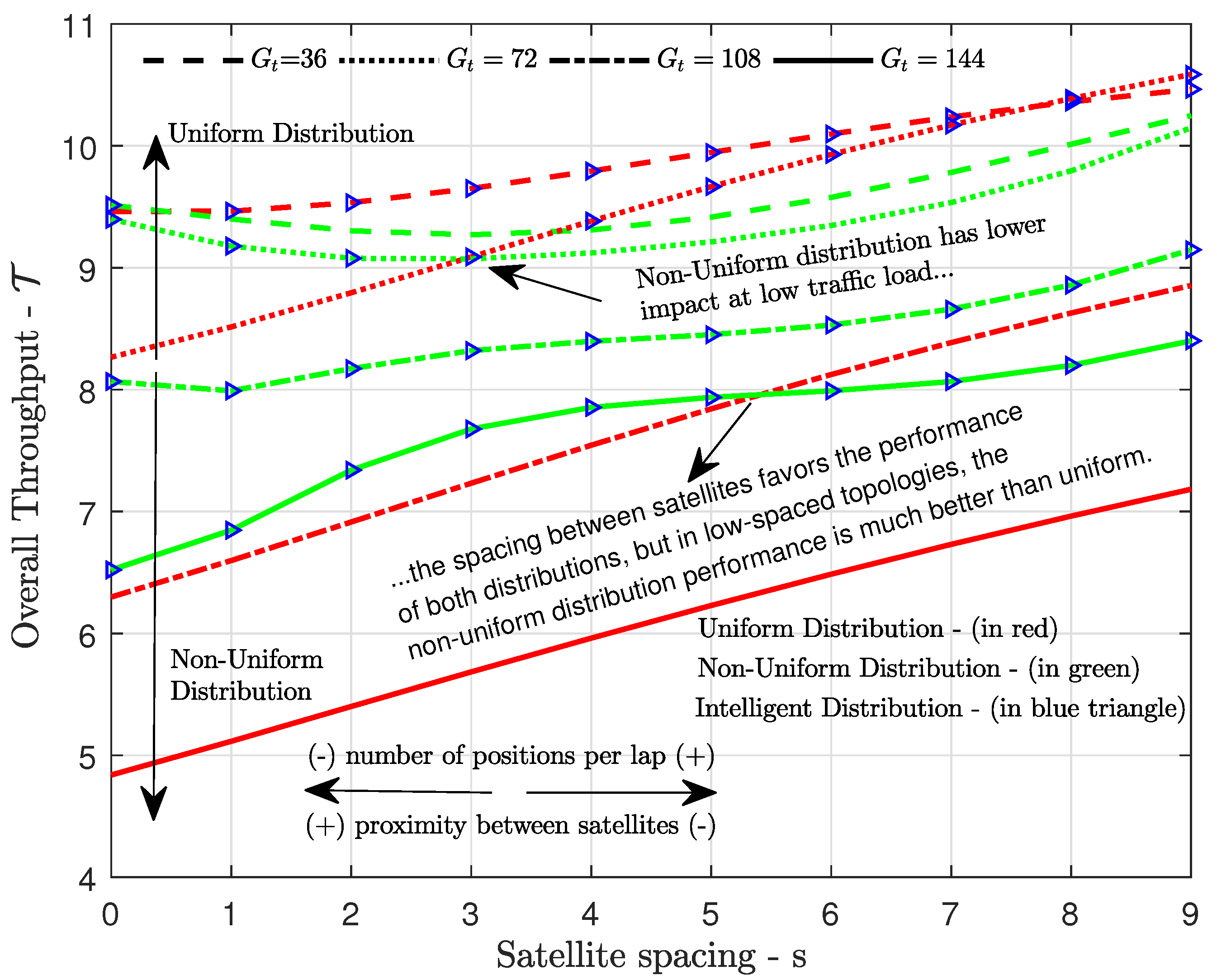
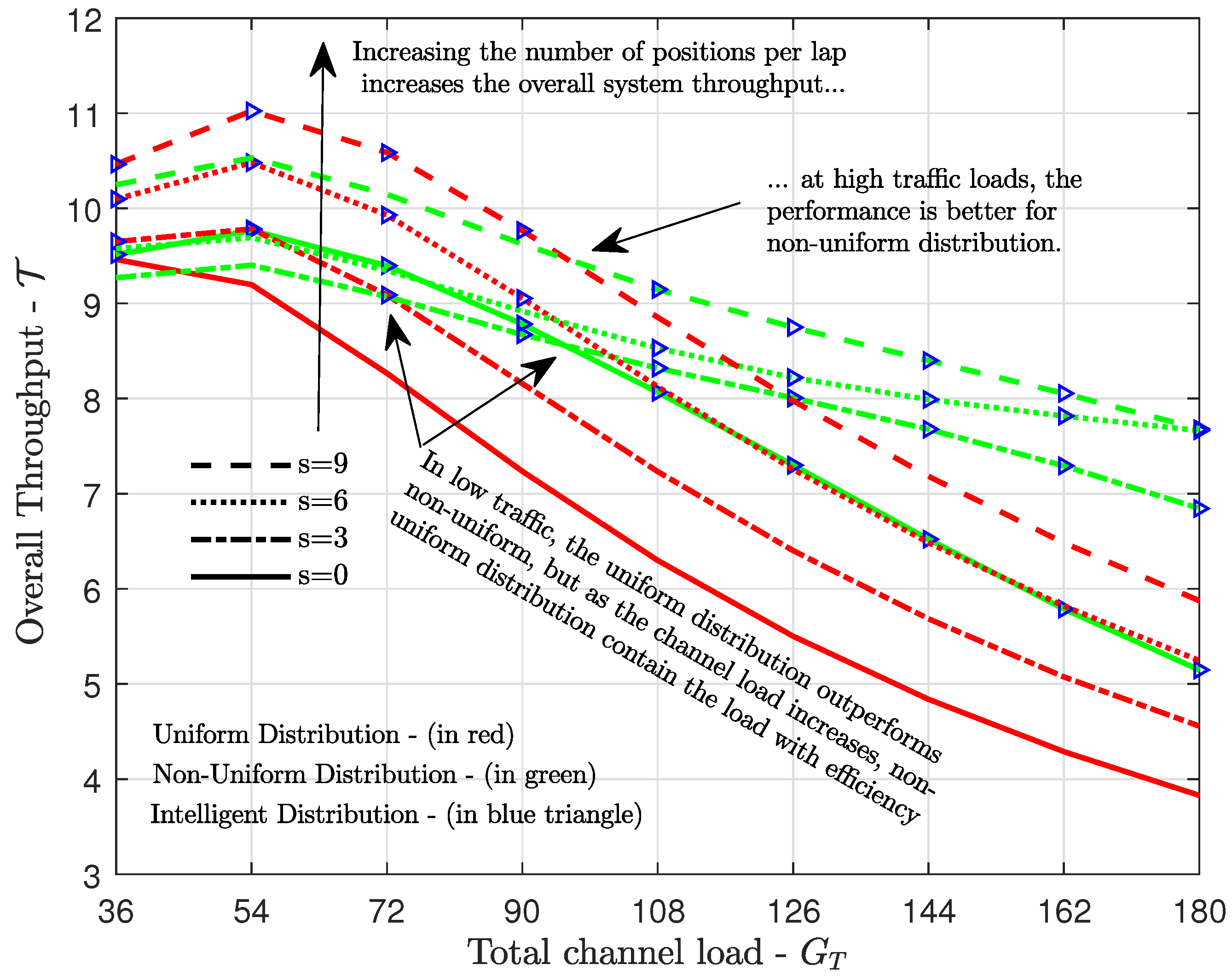
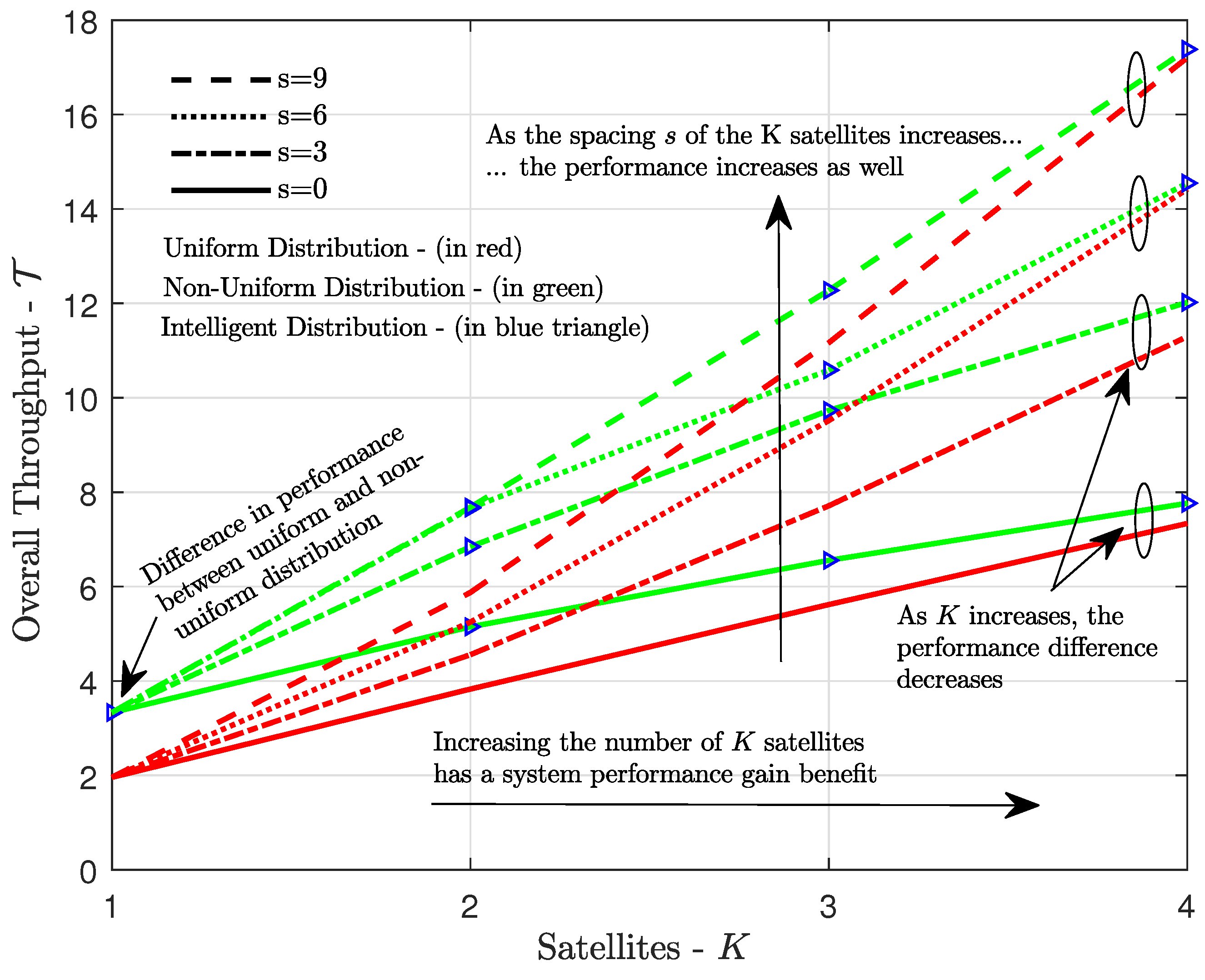
| s | SAT | P1 | P2 | P3 | P4 | P5 | P6 | P7 | P8 | P9 | P10 | P11 | P12 | ⋯ | P18 | P19 | P20 |
|---|---|---|---|---|---|---|---|---|---|---|---|---|---|---|---|---|---|
| 0 | 0.9 | 0.8 | 0.7 | 0.6 | 0.5 | 0.4 | 0.3 | 0.2 | 0.1 | 0.01 | 0.1 | 0.2 | ⋯ | 0.8 | 0.9 | x | |
| 0.9 | 0.8 | 0.7 | 0.6 | 0.5 | 0.4 | 0.3 | 0.2 | 0.1 | 0.01 | 0.1 | 0.2 | ⋯ | 0.8 | 0.9 | x | ||
| 1 | 0.9 | 0.8 | 0.7 | 0.6 | 0.5 | 0.4 | 0.3 | 0.2 | 0.1 | 0.01 | 0.1 | 0.2 | ⋯ | 0.8 | 0.9 | x | |
| x | 0.9 | 0.8 | 0.7 | 0.6 | 0.5 | 0.4 | 0.3 | 0.2 | 0.1 | 0.01 | 0.1 | 0.2 | ⋯ | 0.8 | 0.9 |
Publisher’s Note: MDPI stays neutral with regard to jurisdictional claims in published maps and institutional affiliations. |
© 2021 by the authors. Licensee MDPI, Basel, Switzerland. This article is an open access article distributed under the terms and conditions of the Creative Commons Attribution (CC BY) license (https://creativecommons.org/licenses/by/4.0/).
Share and Cite
Tondo, F.A.; Montejo-Sánchez, S.; Pellenz, M.E.; Céspedes, S.; Souza, R.D. Direct-to-Satellite IoT Slotted Aloha Systems with Multiple Satellites and Unequal Erasure Probabilities. Sensors 2021, 21, 7099. https://doi.org/10.3390/s21217099
Tondo FA, Montejo-Sánchez S, Pellenz ME, Céspedes S, Souza RD. Direct-to-Satellite IoT Slotted Aloha Systems with Multiple Satellites and Unequal Erasure Probabilities. Sensors. 2021; 21(21):7099. https://doi.org/10.3390/s21217099
Chicago/Turabian StyleTondo, Felipe Augusto, Samuel Montejo-Sánchez, Marcelo Eduardo Pellenz, Sandra Céspedes, and Richard Demo Souza. 2021. "Direct-to-Satellite IoT Slotted Aloha Systems with Multiple Satellites and Unequal Erasure Probabilities" Sensors 21, no. 21: 7099. https://doi.org/10.3390/s21217099







